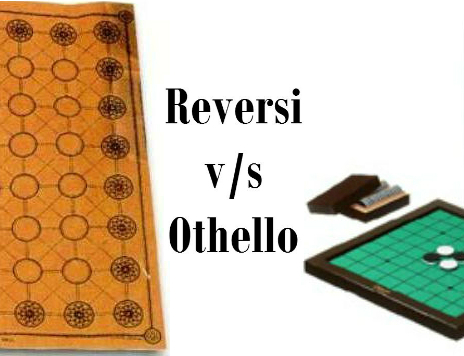Othello news
"Reversi" versus Othello
2 August 2020Written by Ben Seeley

Why do I sometimes see Othello called “Reversi”?
By Ben Seeley
Here’s the long answer: Othello and Reversi are not actually the same game, but Othello has been called Reversi so often that people often think they are the same game (and some game sites, etc., take advantage of that confusion to rip off Othello by calling it "Reversi", which only perpetuates the confusion).
*Real* Reversi is no longer played (as far as I've ever seen). Real Reversi pre-dates Othello, historically, and most expert game players who would investigate the difference would conclude it is an interesting but inferior game. I will explain the differences, and show where the confusion came from.
|
Real Reversi dates back to the 1880s, was briefly a fad in England (it was played in other countries as well), then appears to have mostly died out shortly thereafter. 1. Openings. In Reversi as it was originally played, the starting configuration was not predetermined, like it is in Othello. Players would take turns setting down the first four pieces in the center of the board. Because of this, either player could force the “parallel” starting configuration (White White Black Black), rather than the predetermined Othello starting configuration (White Black Black White). Compared to the Othello starting configuration, the "parallel" starting configuration does not offer a wide range of interesting lines of play. Also, parallel starting configuration may be a White win with perfect play. The Othello starting configuration is almost certainly a draw with perfect play, and there are many draw lines to choose from. Summary of the problem with parallel opening configuration: either player could force a Reversi game to become more boring if they wished, and White could possibly force a winning position from the start, which is less fun for Black. 2. Passes. In Reversi as it was originally played, the game was over as soon as either player could not make a move. In Othello, the player without a move simply passes, and the other player makes as many moves as needed before the first player can make a move again. The game is only over once neither player can make a move. This “no passing” rule in Reversi makes the game radically different and basically screws up normal Othello strategy. 3. Aesthetic differences: Othello is always is played on a green board with black and white discs. Reversi does not have predetermined disc colors. You can find discs in a lot of colours, mostly blue, red, or green. Reversi boards are in different colors and styles. Before 1975, Reversi never had a green board. Now, where does Othello come in? Othello was invented in Japan in the 1960s. Reversi does not appear to have ever been played in Japan. Given how simple and elegant the rules of Othello are, it would be easy to spontaneously invent Othello, having never heard of Reversi before. Either way, Othello is a better game than Reversi, which is part of why Othello became popular (and stayed popular) instead of falling out of popularity like Reversi had done. Unfortunately, because the games look similar and have similar rules, and “Othello” is a trademark and “Reversi” is not, many board game sellers, websites, software makers, etc., wanted to piggy back on the popularity of Othello by calling their game “Reversi”. Quite aggravatingly, they never use the rules of real Reversi (as far as we've ever seen). Instead, they mirror the rules and design of Othello, by making irrelevant tweaks like turning the starting configuration 90 degrees, or having White start play instead of Black, or simply changing the colors of the discs or squares. These differences make literally zero difference to the play of the game- every position is what is known in game theory terms as a "transposition" of the same Othello position, i.e. it mirrors the Othello position. And sometimes, those who call their game "Reversi" don't make any changes at all to the rules or aesthetics, and instead make a perfect copy of Othello, in order to fully exploit the hard work the people in the Othello community have done to promote the game of Othello. They know that paying for an Othello license would cut into their profits, and because so many people think they are the same game, they could get Othello customers (people saying “hey, that looks like Othello”) even though they called it Reversi. This is bad for the players. Also, when a player never knows the game as Othello, and only knows it as "Reversi", it actually limits how much fun the player could be having. If those people playing "Reversi" realized they are actually playing Othello, they could begin to join Othello tournaments (there are no "Reversi" tournaments), read Othello articles online, and join the online and offline Othello community and make great new friends. Instead, many "Reversi" players never get to join the Othello community, and the Othello community does not get to have the pleasure of making friends with the "Reversi" players. This repeated misuse of the name "Reversi" reduces everyone's enjoyment of the great game and community of Othello. That is the long story of the differences between Othello and Reversi/"Reversi". If you have any further information or corrections to add to this article, please email ben dot seeley at gmail dot com. Thank you for reading!
|
Mollets Annextion from 1880. It was a dispute between Waterman and Mollet about who had constructed the game.
|
||




